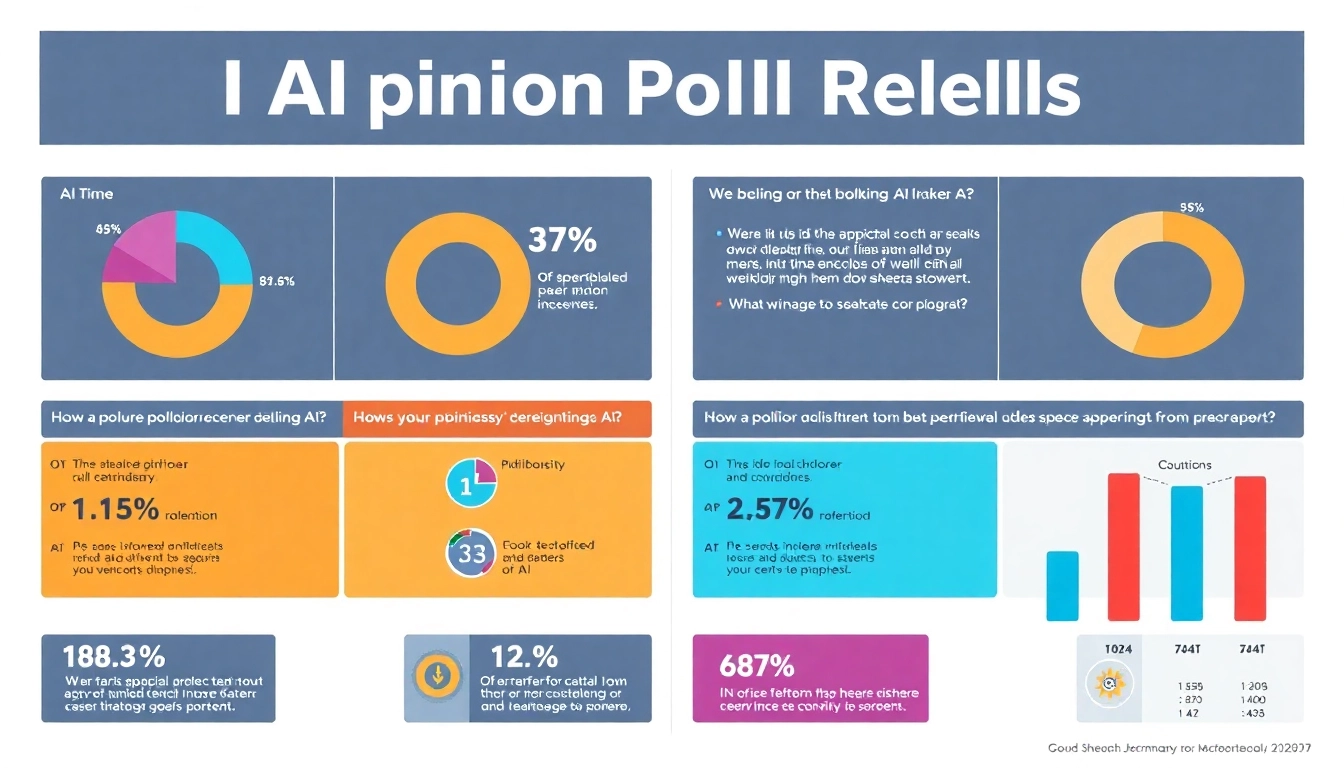Introduction to AI Opinion Polls
What Are AI Opinion Polls?
AI opinion polls are systematically conducted surveys that capture public perceptions, attitudes, and concerns regarding various dimensions of artificial intelligence. These polls utilize both quantitative and qualitative methods to acquire insights into how different demographic groups perceive AI technologies, their uses, and their implications on society. As AI continues to infiltrate daily life, understanding public opinion becomes increasingly vital for informing policy decisions, guiding corporate strategies, and shaping public discourse.
Importance of Public Perception on AI
The public’s perception of AI significantly influences its adoption, regulation, and development. Positive sentiments can drive innovation and funding in AI technologies, while negative attitudes may lead to increased scrutiny and governmental regulations. For instance, a recent AI opinion poll revealed that 52% of Americans express more concern than excitement about AI in their everyday lives, underscoring a need for stakeholders to address these sentiments effectively.
Trends in AI Public Opinion
Tracking trends in AI public opinion reveals shifting sentiments as technology evolves. Recent data indicates a rise in skepticism about the benefits of AI, with many fearing job loss, privacy issues, and misinformation. Year over year, surveys show increasing awareness of both the capabilities and potential risks associated with AI, suggesting a complex relationship between technological advancement and societal readiness.
Analyzing Recent Poll Results
Key Findings from Current AI Polls
Recent AI polls present a multitude of insights into public sentiment. For example, a survey by Gallup indicated that a significant portion of respondents believe AI does more harm than good, particularly regarding job security and misinformation. This consensus indicates a disconnect between technological progress and public assurance, necessitating transparent dialogue from AI developers and policymakers to mitigate fears effectively.
Differentiating Opinions Across Demographics
Public opinion on AI varies considerably across different demographic segments, influenced by factors such as age, gender, and education. Studies have shown that women tend to harbor more concerns regarding AI compared to men. Furthermore, age differences reveal younger populations more likely to embrace AI technologies, while older demographics express trepidation about their implications, particularly concerning job displacement.
Regional Variations in AI Sentiment
AI sentiment is not uniform across regions in the United States. Urban areas often show more optimism towards AI technologies compared to rural regions, which may have less exposure to AI-driven changes. For instance, respondents from metropolitan areas typically report higher usage rates of AI applications in daily life. These regional disparities highlight the need for targeted communications and educational initiatives to build trust and understanding of AI technologies across diverse communities.
Challenges in Interpreting Poll Data
Common Misconceptions About AI Polls
One major challenge in interpreting AI poll data is the presence of common misconceptions. Many people assume that a lack of understanding about AI equates to a negative perception, a simplistic view that neglects the complexity of public sentiment. Misconceptions about what AI can do, its limitations, and the ethical implications surrounding its use can skew public opinion and influence the data collected in these polls.
The Role of Media in Shaping Opinion
Media coverage plays a crucial role in shaping public perception of AI. Sensational stories can amplify fears about AI, reinforcing negative sentiments. Conversely, positive stories about successful AI applications, such as advancements in healthcare and education, can foster optimism. The challenge lies in balanced reporting that addresses both the potential benefits and the risks of AI, providing a nuanced picture that can inform public opinion.
Validating Poll Results: Best Practices
To derive meaningful insights from AI opinion polls, it is essential to validate the results rigorously. Best practices include employing stratified sampling methods to ensure diverse demographic representation and using well-structured questionnaires that avoid bias. Analysts should also look for triangulation of data by comparing results from multiple sources, enhancing the reliability of findings and their applicability in real-world scenarios.
Practical Applications of AI Opinion Polls
Using Poll Data for Policy Making
AI opinion polls can be powerful tools for policymakers. By understanding the prevailing sentiments about AI, governments can formulate policies that address public concerns and promote beneficial applications of AI technologies. For instance, data indicating widespread worry about job displacement can lead to workforce retraining programs, ensuring that technological advancements do not create socioeconomic divides.
Impact on AI Development and Deployment
Informed by public opinion, businesses and developers can tailor AI solutions that meet societal needs and alleviate fears. This may involve engaging with communities to understand their concerns and incorporating ethical considerations into the design and deployment of AI systems. By prioritizing transparency and collaboration, AI developers can foster trust and acceptance among users.
Guiding Public Awareness Campaigns
AI opinion polls can inform public awareness campaigns aimed at demystifying AI. By identifying key concerns that the public has, organizations can craft effective communication strategies that address misinformation and highlight the positive contributions of AI. Campaigns educating the public about AI’s capabilities and limitations are essential for fostering informed dialogue and public trust.
Future Trends in AI Public Opinion Research
Anticipated Changes in Public Sentiment
As AI technologies continue to evolve, public sentiment is likely to shift. Anticipated trends include an increasing demand for ethical AI, where users seek assurance that AI systems are designed with moral considerations in mind. Additionally, as more people experience AI in their daily lives, familiarity may contribute to a gradual normalization of AI technologies, potentially reducing fears and increasing acceptance.
The Role of Emerging Technologies in Polling
Advancements in data collection methods and analytics can enhance the accuracy and depth of AI opinion polls. Emerging technologies such as machine learning and natural language processing (NLP) can facilitate real-time sentiment analysis, providing a more dynamic understanding of public opinions as they develop. These technologies could ultimately lead to more responsive and tailored approaches in addressing public concern and feedback.
Engaging with the Public: Best Approaches
For effective engagement, AI stakeholders should employ strategies that emphasize transparency, inclusivity, and education. This may include open forums for public discussion, educational workshops, and interactive platforms that allow individuals to express their views and experiences with AI. Building an ongoing dialogue fosters an environment of trust, making it easier to address concerns and adapt technologies to serve the public good.























+ There are no comments
Add yours